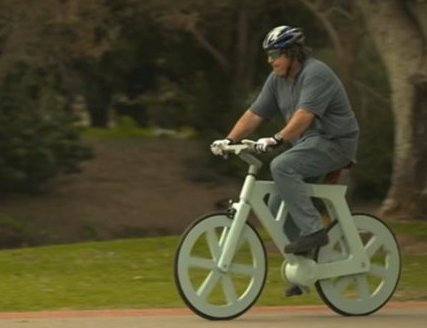
Cyclists come in all shapes and sizes, with different abilities, interests, and goals. Some of them scoff at the idea of a “bicycling community,” contending instead that cyclists have nothing in common other than that they ride bikes. This is true and false.
It is true in the sense of lack of conformity among cyclists. Riding style, bicycle type, and attire vary greatly among cyclists. However, cyclists share certain things in common such as discrimination on the roads, disadvantages when in an accident involving a car, and minority status resulting from using an alternative mode of transportation.
Riding a bicycle as transportation make one an outsider. It goes against the grain of most modern industrialized societies. And it flies in the face of a car-centric, fast living American culture.
In some ways, riding a bike to go places, rather than for recreation, puts one outside the box. It represents doing things in a different way — as some would say, marching to the beat of a different drummer.
Engaging in activities which are outside the box, should, and does, attract people who think outside the box. They like the fact that what they are doing is different from the norm, possibly because they like to invent new ways of doing things to suit themselves and their situation.
Inventiveness and cycling go hand-in-hand. Take the case of avid cyclist, mechanical engineer, and inventor Izhar Gafni. This is a man who likes a challenge. He likes to envision and create new things. He also likes to recycle things for the sake of our planet.
By combining his background in building and designing custom made carbon fiber bikes for high end riders and his experience as a production line expert Gafni designed the first recycled cardboard bicycle.
He was inspired by a story he heard about a man who built a cardboard canoe. Although it took many hours of research and planning, what he essentially did was to incorporate the principles of Japanese origami — the traditional Japanese art of paper folding — in a way that made the cardboard sustainable.
The bicycle was constructed with only $9 worth of cardboard. A coating covers the cardboard, making it resistant to the elements and giving it the look of plastic. Despite being built entirely of cardboard, the bike can carry a rider who weights up to 485 pounds — almost twice as much weight as many aluminum, steel, and carbon bikes manufactured today.
Based on current estimates, the manufacturer expects to sell the cardboard bikes for between sixty and ninety dollars, depending upon whether they are ordered with an optional electric motor. Cardboard Technologies is “all about making a better world for us to live in by two main principals: creating the ability to produce almost any daily product from at least 95% recycled materials and building auto production lines, with a simple post production assembly that will be performed by people with difficulties or disabilities.
Unlimited and incentivized raw materials and incentivized manpower will help us create working places in every location which we will find a local partner at. Our vision is also to bring the factories back from China (starting with the green ones).
The principals of our vision above, will allow our partners and manufactures to receive almost all of the of the production costs of our products back from governmental and global incentives, making our products available to almost any person in any philanthropic or commercial business model.”
Not only did Gafni envision a unique bicycle, but he also had a vision for making the world a better place. Bicycles in this price range can open up a whole new world of opportunities for people in developing countries, as well as for people of limited means throughout the world.
For example, in many countries, children must walk miles to get to school each day. Having a bicycle would make such a trip easier and faster, and keep more kids in school. Employment opportunities would be increased for individuals who have no transportation by widening the area in which they can seek employment. Both of these changes would lead to less poverty and a higher standard of living for a larger number of people.
In addition, the positive environmental impact of such an endeavor is staggering. Cardboard bicycles are made from recycled materials which eliminates all of the environmental stresses caused by manufacturing new materials. A cardboard bicycle is a very green way to travel. And it may appeal to people who haven’t shown much interest in bicycles before due to the affordability of the bikes and the fact that they require no adjustments or maintenance.
Many would-be cyclists avoid taking the plunge when they find out how much a new bicycle costs. They are further intimidated by the perceived need for special clothing and gear and the real need for basic tools to keep the bike in proper working order. Eliminating the upfront costs and reducing the cost of bike ownership could be a real incentive for those who are on the fence.
With respect to cycling attracting people who think outside the box, there is much evidence to this effect. All kinds of original bicycle designs can be seen at bike shows. Even on the street, cyclists demonstrate inventiveness in terms of bicycle enhancements designed to carry all manner of goods.
Some cyclists don’t confine themselves to common bike racks. They fabricate all sorts of boxes, rack extensions, strapping mechanisms, and trailers to haul whatever it is they want to carry on or by their bikes.
Using a bicycle to transport oneself and one’s belongings in a world designed for travel by car takes ingenuity. Problems present themselves. And problems must be solved, sometimes on the fly. True cyclists face these problems, undaunted, because they are not afraid of thinking outside the box.



